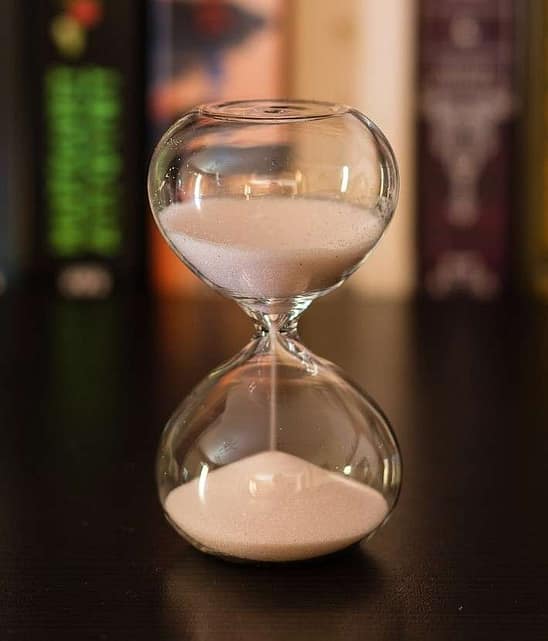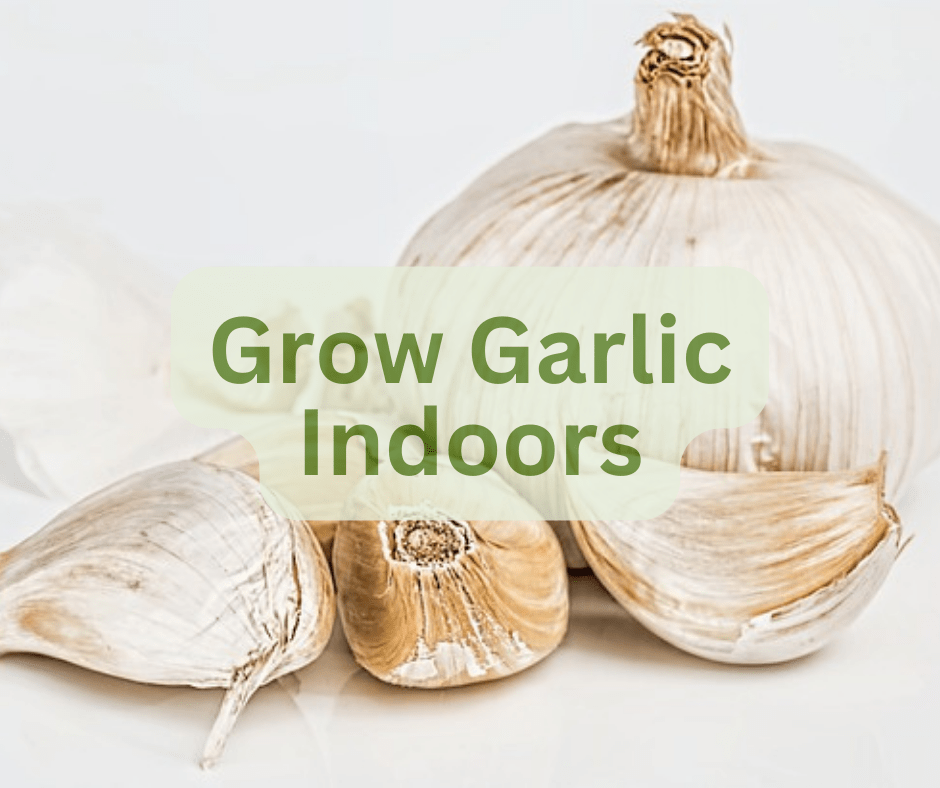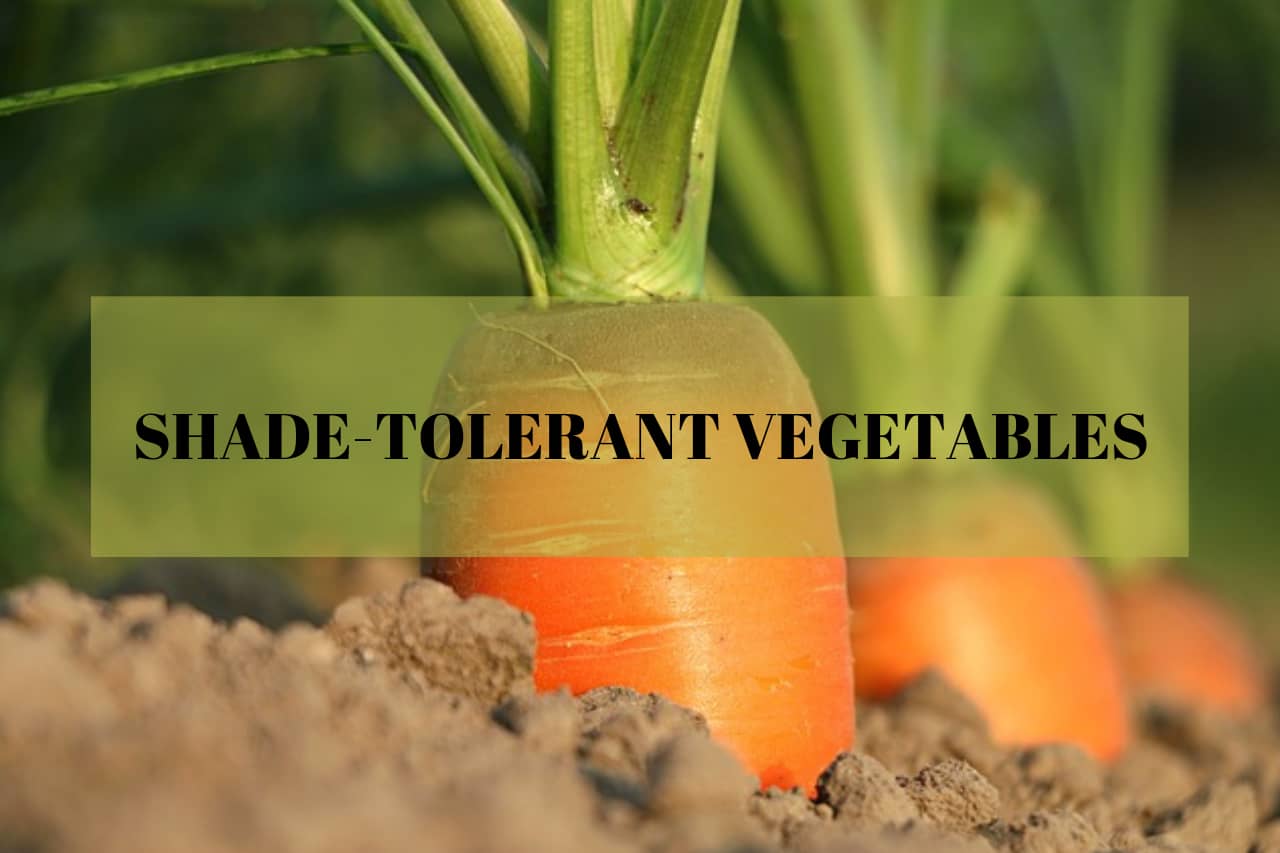This post may contain affiliate links. As an Amazon Associate we earn from qualifying purchases.
It’s almost here. Garlic season. Learn how to grow garlic indoors!
It’s an exciting time for those of us who happen to love that stinky little bulb, foodies and non-foodies alike.
We recently showed you, in-depth, everything you need to know about growing garlic in the garden. And, thanks for all the kudos on that one.
A lot of the emails we received, however, asked if it is possible to grow garlic indoors. And, yes, it certainly is. Today we dive deep into that topic, so read on!
First, Get to Know the Types of Garlic
When you shop for garlic (Allium sativum) to plant indoors you’ll notice there are two categories, hardneck and softneck.
Hardneck garlic bulbs
- Hardneck garlic is closely related to wild garlic. The ‘hardneck’ describes the hard stalk, which isn’t present in softneck garlic.
- This stalk will produce an edible scape with a flower.
- Hardneck garlic is easier to peel and has more flavor than softneck garlic, making it the favorite of professional chefs.
- The most important difference between the two, at least for the gardener, is that hardneck garlic requires vernalization. This is a period of very cold weather. Without it, the garlic will not form cloves.
Softneck garlic seed
- Softneck garlic bulbs contain more cloves than their hardneck cousins. Since they don’t produce a flower stalk, it puts its energy into the bulb.
- The cloves are typically smaller in a softneck bulb than in a hardneck bulb.
- It’s an easy grower and lasts longer post-harvest than the hardneck garlics; “… six to eight months as compared with hardneck’s two to four months,” according to Phyllis Frederick, Erika Leviant and William Hlubik with Rutger’s University’s Agricultural Experiment Station.
- The braided garlic? Those are softnecks.
- Supermarket garlic? Softnecks as well.
Obviously, if you’re going to be growing your garlic indoors, and unless you have a blizzard machine you want to keep running all winter, you’ll need to grow softneck garlic.
Let’s take a look at some of your choices when it comes to varieties.
The Best Garlic to Grow Indoors
Garlic comes in many varieties, each with its unique flavor profiles and growth characteristics. We polled our garlic aficionado growers and here are their recommendations (and one from the Gardenologist team!)
‘Inchelium Red’ Interested in growing an award-winner? Inchelium Red won the hearts of evaluators in 1991, snagging first place in flavor among 20 competitor varieties at the Rodale Food Center. Inchelium Red boasts an average of 15 cloves in a 3-inch bulb.
‘Early Purple Italian’ Three of our gardening friends recommended this variety because, they say, it’s so easy to grow, “and it’s pretty!” It’s quite popular in and around Gilroy, California, home of the famous Gilroy Garlic Festival.
‘Cal Early’ This one boasts about 8 cloves per bulb (give or take), is non-GMO and is an heirloom variety. If you want an early harvest, choose Cal Early. This is our pick, but be aware that it’s quite mild.
How Long Does it Take to Grow Garlic Indoors?
The time it takes to grow garlic indoors from seed to harvest can vary, but generally, you can expect the following timeline:
- Planting: Garlic is typically planted in the fall, around 4-6 weeks before the first expected frost. For indoor gardening, you can plant it year-round.
- Germination: Garlic may take a few weeks to sprout, usually 7-10 days, but it can be longer in some cases.
- Growth and Bulb Formation: Garlic requires several months to develop bulbs fully. Depending on the variety and growing conditions, this can take anywhere from 90 to 150 days.
- Harvest: Harvest your garlic when the leaves start to turn yellow and wither, typically in late spring or early summer. We wait until at least half of the foliage is yellow. Dig up the bulbs carefully to avoid damaging them.
What Size Pot is Best for Growing Garlic Indoors?
When growing garlic in containers, size matters.
In fact, the choice of pot size is crucial for the success of your indoor garlic project. Garlic bulbs require ample space for their roots to develop, so opt for a container that’s at least 8 to 12 inches deep and 6 to 8 inches in diameter.
This will provide enough room for the garlic bulbs to develop and mature properly.
How to Choose Soil
Next, consider the soil in which your garlic will thrive. Garlic prefers well-draining soil with good fertility.
A potting mix that combines equal parts of regular potting soil, compost, and perlite or vermiculite is an excellent choice.
The compost enriches the soil with essential nutrients, while perlite or vermiculite ensures proper drainage. This combination provides the optimal conditions for your garlic to flourish.
Where Do I Find Garlic to Plant Indoors?
Now that you have your pot and soil ready, it’s time to find garlic bulbs for planting. You can often find suitable garlic bulbs at your local garden center, nursery, or online (follow the links under “The Best Garlic to Grow Indoors,” earlier in this post).
When making your selection, look for bulbs that are firm and free from any signs of mold or disease. It’s essential to choose healthy bulbs, as this will set the foundation for a successful indoor garlic garden.
How to Plant Garlic in Pots
Remove all the cloves from the garlic head and, no, you don’t need to remove the outer, papery covering on each clove, although we always do. There’s no reason in particular, it just feels like it’s something we should do. Crazy, right?
Plant each clove, pointed end up, 2 inches deep. Larger cloves can go a bit deeper, up to 4 inches.
The width between cloves is important. Keep them 6 inches apart.
Water the potting soil until the excess water drains from the bottom of the pot. Remember to keep the soil moist while the “seeds” germinate. The moisture content should be similar to that of a well-wrung sponge.
Apply the water at the base of the plant to avoid wetting the leaves, which can lead to fungal issues.
Find the Sweet Spot for your Garlic Plants
You’ll need to find a spot indoors that gets lots (at least 6 to 8 hours) of direct sunlight. That is where your garlic plant will do best. If natural light is insufficient, you can supplement it with a grow light.
Garlic thrives in cooler temperatures. Aim to maintain a temperature range of 55-75°F (13-24°C) for optimal growth. Avoid exposing your garlic plants to extreme heat, as this can hinder bulb development.

Garlic doesn’t have specific humidity requirements. However, it generally does well in typical indoor humidity levels. If your indoor environment is exceptionally dry, consider using a humidifier to maintain adequate moisture.
Pests to Watch Out For
While indoor garlic cultivation generally reduces the risk of pest infestations compared to outdoor gardening, there are still some beasties to be aware of:
- Aphids: These tiny, sap-sucking insects can infest your garlic plants. Regularly inspect your plants and wash them with plain water to remove the aphids. Use insecticidal soap for large infestations, but keep the plant in the shade after treating it.
- Spider Mites: These minuscule arachnids can spin webs on your garlic plants and weaken them. Keep your indoor space well-ventilated, as spider mites thrive in dry conditions. Battling them can be a real challenge, however. Spray neem oil or horticultural oil directly onto adult mites, any larvae you may be able to see. It should kill them on contact but reapply in 3 days to be sure. Keep the garlic plants out of the sun during treatment and until you’ve rinsed it from the foliage.
- Fungus Gnats: These small, flying insects lay their eggs in the soil and their larvae can, but rarely, harm your garlic’s roots. They are mostly annoying as they multiply quickly and tend to fly in people’s faces. To prevent infestations, allow the soil to dry out slightly between waterings. To kill fungus gnats, we use Mosquito Bits, which contain Bacillus thuringiensis, a soil bacterium. It’s safe and effective. You may have to treat the plants two or three times, but this product does eliminate them.
Frequently Asked Questions
Can you grow garlic indoors all year round?
One of the fantastic advantages of growing garlic indoors is that you can enjoy fresh garlic year-round.
By staggering your plantings every few weeks, you can ensure a continuous supply of garlic throughout the year. This is especially handy for home cooks who love to use garlic in their culinary creations regularly.
Can you plant garlic in the spring?
Nope. The best time to plant garlic is in the fall, between September through the end of November. It will form roots throughout the fall and winter. By spring, the roots are robust enough to support the fast-growing foliage which, in turn, is necessary to grow the garlic bulb. “Bulb growth is poor and yields low if planted in the spring,” according to the experts with Utah State University Extension.
Can you plant sprouted garlic?
You can, but it probably won’t produce the way you hope it will. Garlic, when stored below 40 degrees F, will sprout. Remember, when planted at the proper time, the garlic will first produce roots. If it produces a sprout first, the plants may not mature or mature too early.
By the way, don’t store the bulbs at 50 degrees or warmer because the opposite will happen; the garlic will sprout late and be late to mature.
Mention of a pesticide or fungicide is for educational purposes only. Always follow the pesticide label directions and cautions. Ensure that you wait the required number of days between pesticide application and when you can harvest your crop (that information is on the label).





